San Agustín
Colombia
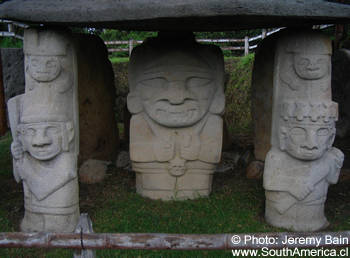 San Agustin is the home to one of the continent's most important archaeological sites. The area is dotted with freestanding monumental statues carved of stone left behind by a mysterious pre-Colombian civilization that existed between the 6th and 14th century AD. The statues were markers of ceremonial and burial sites where they buried their dead in the fetal position with personal objects such as pottery and gold within tombs underground.
San Agustin is the home to one of the continent's most important archaeological sites. The area is dotted with freestanding monumental statues carved of stone left behind by a mysterious pre-Colombian civilization that existed between the 6th and 14th century AD. The statues were markers of ceremonial and burial sites where they buried their dead in the fetal position with personal objects such as pottery and gold within tombs underground.
San Agustin is a great little friendly town (though expect to have a couple of travel agencies rush you when you first get off the bus, but after this people leave you alone) and surrounding area. Contrary to what has been written about this area, it is now a safer place for travelers to visit and explore; guerilla activity has diminished dramatically with the increase of military presence in the area. You will find the Colombians in the south are generally friendlier than the north; not to say northern Colombians are unfriendly.
Treks around the statues
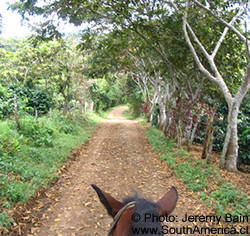
Most travelers hire horses or a jeep for visiting the archeological sights of the freestanding monumental statues around San Agustin. If electing to do the horse riding and you do not want to fork out the extra costs associate with having a guide, think about having one of the local school boys accompany you on your trek, they will sit on the back of one of the horses, they should be able to provide knowledge of the sites. The kids helping to guide you have learned to complain about being hungry and thirsty, hoping that this will spark your extra generosity.
Beware of tour guides who try to arrange everything for you. Many people have experienced a lot of problems here with tour guides not living up to their end of the bargain and poor quality tours and accommodation. (Especially be cautious of a woman named Olga). You should also be on guard for people trying to sell you "authentic" artifacts. If they were authentic (which they aren't), it would be illegal.
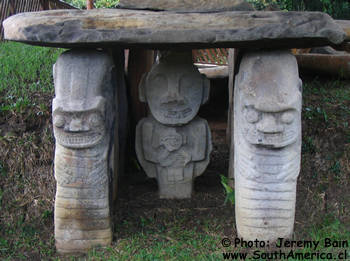
Parque Arqueologico (Archaeological Park)
If you are doing a half day trek in the morning and organizing for the guide to end the treks at the entrance to the park; a couple of hours here is sufficient. The Park is well worth a visit for its display of freestanding monumental statues carved in stone which have been well preserved compared to the statues you visit on the trek. If you're not interest in paying for a guide to show you around the park, it is worth visiting the small museo (museum) first. Though it has limited information, it definitely provides you with enough information to make the visit around freestanding monumental statues more enjoyable. Collectivos (shared taxis) frequently pass the entrance of the museum, which will drop you back in San Agustin.
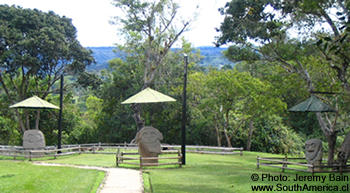
Where to Eat
If dining and you want to make sure you have a selection of places to choose from, eating before 7.30pm is a good idea, as places will close when they feel like it, especially if there are no customers.
If your hunger is calling for something more like what you get back home, there is a great little pizza place we found. It is half way up a street that comes of the main road opposite the main plaza, it has a pink neon light outside and is owned by a half French half German women who came here as a tourist many years ago and forgot to leave. She does not have a menu you just tell her what you desire on our pizza. She even offers to divide the toppings up by slice so you can try all sorts of funky combinations!
There is also a cheap little burger bar on the main road before you get to the small hill on the way to the main plaza that has surprisingly good burgers and fries, a small trip will get you the biggest smiles you have ever seen.
Where to Stay
There is a multitude of accommodation to choose from in San Agustin. There are a few basic hotels on the main street or a homestay hostel style place on the outskirts of town. Most come with mixed report from travelers.
Hotel Colonial in the centre of town is simple and cheap but walls between the rooms and beds are a bit thin, the guide associated with the hotel is very reliable in sorting you out horses or jeep tours of the surrounding archaeological sites.
The Homestay hostels on the outskirts of town are a worthwhile opportunity if you are staying here for a couple of nights, as they offer a bit of peace and tranquility (not that the town is hectic). You may want to take a few snacks with you to save the hike back into town.

Getting there and away
If you plan on skipping Cali and the coffee region and heading straight to Popayán and San Agustin from Bogotá the best option for transport is to get a bus to San Agustin from Bogotá and then a bus to Popayan for the trip south; also buses are cheaper to San Agustin than Popayan. If heading north, a really good service is Taxi Verde which leaves San Agustin at 7am everyday. However, it has been my experience that this is one of the circumstances where the bus driver stops every 5 metres to drum up extra business and the trip can take up to 11 hours, not the 9 hours they advise.
If you are heading south from San Agustin and wanting to try an alternative route, there is good tar sealed road from San Agustin to Mocoa where you can change buses for Pasto. From Mocoa peering out the bus window at the country side far below as the bus overhangs the road sounding it's horn, swinging around tight corners, winding it's way up the steep one lane mountain side makes a great little adventure. Especially exhilarating is knowing that this is a wild bus ride experience made by few other travelers (that live to tell the story ;) ). The journey from Mocoa to Pasto will take about 6.5-8 hours depending on the bus. If you want to pay a little more there are collectivos that run the route and are fasters than buses.
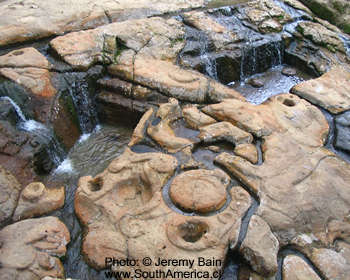
If you found this guide about San Agustín, Colombia interesting or useful, let others know about it.

